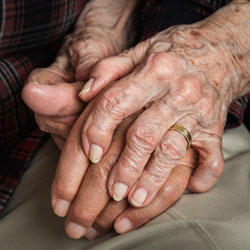5.2 Signs that death is near
In the next activity you will continue to follow Frank and Grace in his last days. The National Council for Palliative Care website has a page on Signs that death is near [Tip: hold Ctrl and click a link to open it in a new tab. (Hide tip)] . Being able to recognise these signs can help relatives and others close to the person to prepare for what is to come and to say goodbye.
Activity 6
Part 1
Read the National Council for Palliative Care list of indications that someone is approaching death.
As death approaches, you may see some or all of the following changes:
Physical changes
In older people the skin can become paper-thin and pale, with dark liver spots appearing on hands, feet and face. Hair can also thin and the person may shrink in stature. Teeth can discolour or develop dark stains.
Shrinking world
The person’s external world begins to diminish until the dying person no longer wants to leave the house or their bed and may not want to talk very much. Their mood, character and behaviour may change. For example, some may become more anxious. Others who have held atheist views may suddenly want to explore religious or spiritual teachings.
Increased sleep
The person begins to sleep for long periods. This can be distressing for relatives, but it’s important to understand that even the mildest physical exertion for someone approaching death can be exhausting, and for the moment all effort is being put into staying alive. Nearer the end, the dying person may increasingly drift in and out of consciousness.
Appetite reduction
Appetite reduces as the body knows it no longer needs fuel to keep it going so those who are dying often lose their desire to eat or drink. They can begin to lose weight, sometimes rapidly. It’s important not to force food or drink onto someone who no longer wants it.
Expression
There may be changes of expression where the person may start to talk about ‘leaving’, ‘flying’, ‘going home’, ‘being taken home’, ‘being collected’, ‘going on holiday’ or making some kind of journey. They may also begin to express heart-felt gratitude to their carers and to their family as a preparation to saying their farewells.
Special requests
The person might make special requests, such as asking for something special, wanting to visit a particular place, or wishing to be surrounded by their favourite flowers. They may want to hear certain music, to have family photographs nearby or to make contact with someone who has been important in their lives. Some special requests might be difficult to fulfil, especially if they are unusual or illegal such as the choice of disposal of the body. It would be helpful to discuss unusual or illegal requests with a professional who might be able to clarify what can be done, and what alternatives might be considered.
5.1 Advanced care plans


